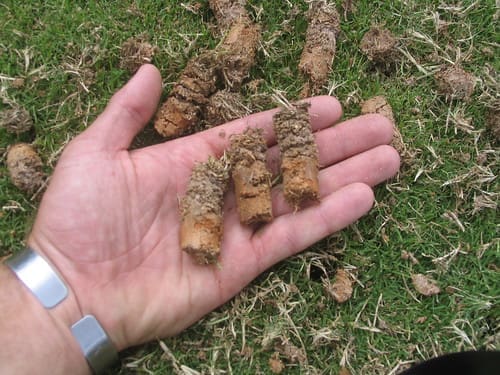What is Core Aeration?
Why Core Aeration is Important?
Over time, soil compaction can restrict the flow of essential nutrients, water, and oxygen to the grass’s roots. Core aeration helps alleviate this compaction by removing small plugs of soil, thereby creating pathways for roots to expand and absorb more nutrients (Scotts, n.d.). This process also enhances water infiltration, reduces runoff, and helps the lawn withstand drought and heat stress (TruGreen, n.d.).
What are the Benefits of Core Aeration?
- Improved Nutrient Uptake: Core aeration allows fertilizers and other nutrients to penetrate the soil more effectively, leading to healthier and greener grass (Penn State Extension, n.d.).
- Enhanced Soil Composition: Aeration improves soil structure by reducing compaction and thatch, facilitating better air exchange and healthier soil (University of Maryland Extension, n.d.).
- Stronger Roots: The process encourages deeper root growth, making your lawn more drought-resistant and better equipped to survive harsh conditions (Scotts, n.d.).
- Reduced Water Waste: By improving water absorption, aeration minimizes water runoff and ensures that more water reaches the roots, reducing the need for frequent watering (TruGreen, n.d.).
- Thatch Control: Aeration helps break up thatch, a layer of dead grass and roots that can suffocate your lawn if not properly managed (The Lawn Institute, n.d.).
Pros and Cons of Core Aeration
Aeration Pros:
- Enhanced Growth: Aeration promotes thicker, healthier grass by improving root development (Penn State Extension, n.d.).
- Reduced Soil Compaction: It alleviates compacted soil, allowing roots to grow more freely and deeply (University of Maryland Extension, n.d.).
- Better Water Absorption: Ensures that water penetrates deeply into the soil, reducing the frequency of watering (TruGreen, n.d.).
- Healthier Lawn: Aeration reduces thatch buildup and encourages a lush, green lawn (The Lawn Institute, n.d.).
Aeration Cons:
- Time-Consuming: The process can be labor-intensive and time-consuming, especially for larger lawns (Scotts, n.d.).
- Initial Unsightly Appearance: Aeration leaves behind small plugs of soil on the lawn, which may be unsightly until they break down (Penn State Extension, n.d.).
- Cost: Hiring professionals for aeration can be costly, though the investment typically pays off in lawn health (University of Maryland Extension, n.d.).
When and How to Aerate Your Lawn
The best time to aerate your lawn depends on the type of grass you have:
- Cool-Season Grasses: Aerate in early spring or fall when the grass is actively growing (Penn State Extension, n.d.).
- Warm-Season Grasses: Aerate in late spring or early summer during their peak growing season (Scotts, n.d.).
For best results, it’s recommended to water your lawn a day before aeration to soften the soil. After aeration, you can leave the soil plugs on the lawn to decompose and return nutrients to the soil (The Lawn Institute, n.d.). It is also an ideal time to overseed and fertilize your lawn, as the aeration process provides the perfect environment for new seeds and nutrients to thrive (TruGreen, n.d.).
Lawn Services That Complement Core Aeration
- Overseeding: After aeration, overseeding your lawn can help fill in bare spots and create a denser, more uniform lawn. The seeds can penetrate the soil more effectively through the aeration holes, leading to better germination (University of Maryland Extension, n.d.).
- Fertilization: Applying fertilizer after aeration allows nutrients to reach the root zone more effectively. This timing helps promote rapid growth and recovery of the grass (Scotts, n.d.).
- Topdressing: Topdressing with a thin layer of compost or soil after aeration can further improve soil structure and nutrient content (Penn State Extension, n.d.).
- Dethatching: If your lawn has a significant thatch layer, dethatching before aeration can help improve the effectiveness of the aeration process (The Lawn Institute, n.d.).
Conclusion
Core aeration is a crucial lawn care practice that offers numerous benefits, from improved root development to better water and nutrient absorption. While it requires some effort and investment, the rewards of a healthier, greener lawn make it well worth the time and cost. By combining core aeration with complementary services like overseeding and fertilization, you can maximize the health and beauty of your lawn. Barefoot Lawn Care can assist with your lawn aeration needs!
References
Penn State Extension. (n.d.). Core aeration for lawns.
Scotts. (n.d.). Lawn aeration: What it is, how to do it, and when.
The Lawn Institute. (n.d.). Aeration.
TruGreen. (n.d.). Why, when, and how to aerate your lawn.
University of Maryland Extension. (n.d.). Aerating your lawn.

